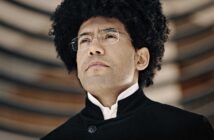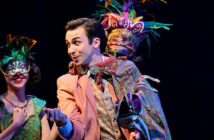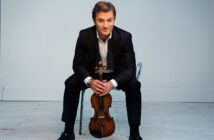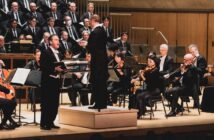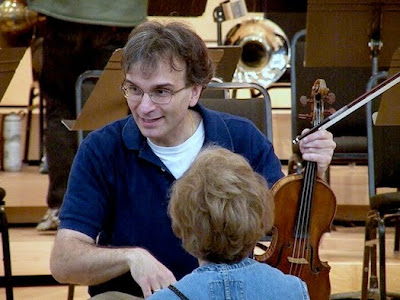
SUMMER MUSIC FESTIVALS 2010
Aspen Music Festival and School
After a few days in Vail enjoying the music-making of Jaap van Zweden and the Dallas Symphony at the Bravo! Vail Valley Music Festival, Marita and I drove over to Aspen, about 100 miles away through the mountains. What we found there was a much older community and a festival and school operating on an equally high artistic plane but with a more varied range of goals and activities. True, Aspen has been in the news lately for its administrative infighting which saw music director and conductor David Zinman suddenly resign, and president Alan Fletcher emerge as the man in charge going forward, but on the basis of the two concerts I heard – actually one concert and a dress rehearsal – Aspen is maintaining its status as one of the world’s great oases of musical nurture and development.
Aspen Festival Over Half Century Old!
The Aspen Festival was founded in 1949, and in its formative years it was a philosophy rather than a full-fledged festival. What came to be called “The Aspen Idea” meant a place where people could develop in body, mind and spirit. Soon there was a school and more and more concerts and a performing space was built based on a design by the legendary Finnish-American architect Eero Saarinen. As a Finnish-Canadian, Marita took special pleasure in discovering this fact about Aspen.
Saarinen’s tent was replaced by a more permanent structure designed by Herbert Bayer and Fritz Benedict in 1965, and then in 1999 an even more elaborate building was erected – the Benedict Music Tent – designed by architect Harry Teague and acoustician Larry Kirkegaard. The “tent” had now become a 2,000 seat concert hall with a stage spacious enough to accommodate a large orchestra and chorus. An unusual feature of the construction is the tensioned membrane ceiling created by Birdair. The material, known as fiberglass fabric membrane, lets the light in but keeps out the heat of the sun, and apparently does no harm to the acoustics. The sound in the Benedict Music Tent is far more reverberant than one would expect and the overall effect in the two performances I heard – one by a string quartet and the other by a large orchestra – was very impressive.
Chamber Music in 2000 Seat Hall Acoustically Sound!
The Emerson Quartet presented a programme devoted to music by Dvořák, Barber and Shostakovich. I feared their sound might be lost in so large a hall, but that was not the case; possibly the effect of a wooden semicircular baffle placed behind them. I was delighted to hear the Emerson playing some of my favourite music: Dvořák’s Cypresses. These pieces began their lives as songs, and years later Dvořák reworked them for string quartet. Dvořák was a master of string quartet writing and these are some of his most beautiful works. To really appreciate them, the proactive listener would be richly rewarded by comparing the two versions of each piece.
Cypresses was followed by Dvořák’s String Quartet in E flat major Op. 51, to my mind not one of his best. Nonetheless, the Emerson Quartet gave it the careful preparation and total commitment it gives to every piece it plays.
After intermission came the original version of Barber’s Adagio for Strings. Coincidentally, I was to hear the more popular string orchestra version played by the Dallas Symphony in Vail the following night. Both versions are effective but in quite different ways. The quartet version has its own special intimacy, while the orchestra version has a strength and power which cannot be achieved by four players.
Finally, the Emerson played the String Quartet No. 9 Op. 117 by Shostakovich. Its last movement is one of the most exciting in any of the composer’s fifteen string quartets, and the Emerson played it superbly. The chordal pizzicati rang out with accuracy and authority and the contrapuntal writing had boundless energy. The Emerson Quartet brought the audience to its feet and then let it down gently and eloquently with an excerpt from Bach’s A Musical Offering.
Open Rehearsal with Hans Graf and soloist Gil Shaham
The next morning I was back in the Benedict Music Tent for the dress rehearsal of a concert by the Aspen Chamber Symphony (ACS) under the direction of Hans Graf, music director of the Houston Symphony. The ACS is one of three Aspen orchestras and each one is a remarkable ensemble. They combine well-known principal players from orchestras around the world and gifted students who have auditioned and succeeded in being accepted at Aspen.
ACS concertmaster is Alexander Kerr, Professor of Violin at Indiana University, and former concertmaster of the Royal Concertgebouw Orchestra of Amsterdam. Principal second violin is Espen Lilleslåtten, concertmaster of the Bergen Philharmonic in Norway, and principal clarinet is Theodore Oien who holds the same position in the Detroit Symphony. All the members of the American Brass Quintet teach at the Aspen School and play in one of the orchestras…and on it goes.
The Aspen orchestras also have a Canadian component. Principal clarinet in the Aspen Festival Orchestra is Joaquin Valdepeñas of the Toronto Symphony, and principal horn is John Zirbel of the Montreal Symphony.
“Composer in Residence” Christopher Rouse Takes Notes
One of the highlights of the dress rehearsal was the opportunity to hear Odna Zhizn (A Life) by Christopher Rouse with the composer in attendance and basically supervising the performance. Odna Zhizn was conceived as a tribute to Natasha, a Russian friend of the composer. Rouse has said that the piece functions “both as the public portrayal of an extraordinary life as well as a private love letter.” The work had its premiere just a few months ago by Alan Gilbert and the New York Philharmonic.
Like all of Rouse’s orchestral music it is dazzling in its orchestration and dramatically powerful. Rouse seemed generally happy with what he heard and at this final stage of rehearsal only made a few comments about balance. It certainly seemed to me that Hans Graf and the Aspen Chamber Symphony had prepared the piece very well indeed.
Sheer Joy: Shaham Shares Talent and Temperament
The other major work was the Brahms Violin Concerto with Gil Shaham as soloist. Shaham has been coming to Aspen regularly since his student years and he is particularly renowned for his interpretation of this piece.
Now 39 years old, Shaham still exudes a youthful wonder at the world around him. As the orchestra plays the introduction to the first movement, Shaham looks at the conductor and at members of the orchestra as if to say “How can it be so beautiful?” And Shaham’s attitude is as infectious as I am sure it is intended to be. The players in return re-examine the music they are playing as if they had never seen it before, and can’t believe what they are seeing and hearing.
It almost goes without saying that Shaham’s violin playing was joyous and nearly impeccable. But it should be said that while he and Nadja Salerno-Sonnenberg, whom I heard perform in Vail, share an intense commitment to music, they are very different personalities and interpreters. Salerno-Sonnenberg seems to bare her soul in everything she plays, and doesn’t hesitate to go to the dark side if she thinks the music requires it. Shaham, on the other hand, is more of a classicist. It is simply not part of his DNA to personalize the music. Fortunately, there is room for both types of performers in classical music.
Aspen, Colorado: So Much More to Offer than Slopes!
Like Vail, Aspen is primarily a skiing destination. Because of its limited size – it has mountains on three sides – with the crowds that come in winter and more recently in summer too, it is a very expensive place to live. There are only about 6,000 residents and many of them are jetsetters on the order of Michael Douglas, Goldie Hawn, Jack Nicholson and Charlie Sheen. And they generally arrive in Aspen in private jets, dozens of which were parked at the Aspen Airport during my visit. The people who have to earn a living in Aspen mostly live in less glamorous towns nearby.
The Aspen music festival runs for eight weeks and involves about 700 students and 150 faculty, but it’s not the only act in town. Every summer, the very prestigious Aspen Institute attracts many of the most famous minds in politics, economics and the media, The recent Aspen Ideas Festival featured the likes of Bill Gates, Thomas Friedman, Alan Greenspan, David Gergen, and Arianna Huffington.
For Those Wanting More…
The Emerson Quartet recorded all the Shostakovich string quartets in 2000, and they are available in a boxed set as DG 463 2842 2. If you want to hear exactly what Shostakovich had in mind, investigate the recordings by the Beethoven Quartet; this is the ensemble which premiered most of Shostakovich’s string quartets. Their recordings, made between 1956 and 1974, had the approval of the composer. They are now available in a boxed set from DOREMI as DHR-7911-5, and the remastering and restoration work done by Jacob Harnoy is excellent.
Dvořák’s Op. 51 and Cypresses are included in the latest Emerson release as DG 477 8765 5. Gil Shaham has a DVD of the Brahms Violin Concerto with Abbado and the Berlin Philharmonic, recorded at a concert given in Palermo in 2002 (EuroArts 2051987).
Paul E. Robinson is the author of Herbert von Karajan: the Maestro as Superstar, and Sir Georg Solti: His Life and Music, both available at Amazon.com.
NEW for friends! The Art of the Conductor podcast.
Photo of Gil Shaham by Marita


